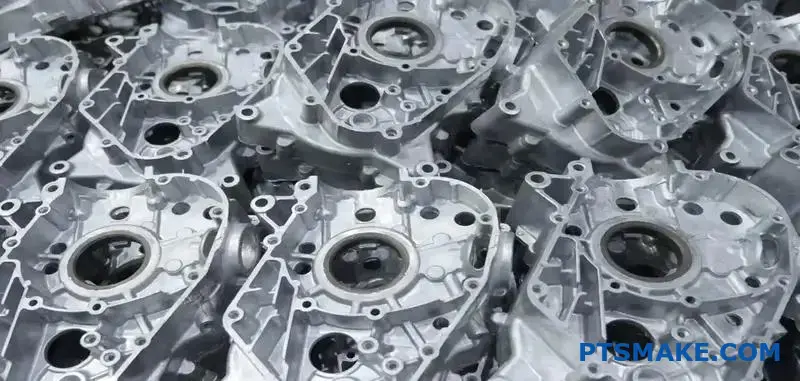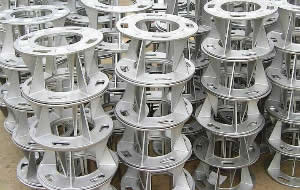Aluminum Casting Explained: Key Truths and Insights for Industry Professionals
Aluminum casting acts as a crucial process in modern production, forming parts across various sectors. Its diverse techniques, such as sand and die casting, provide to different production needs. The special residential properties of aluminum alloys improve their applicability, yet tests stay in preserving quality and efficiency. Recognizing these aspects is vital for market professionals. What are the most up to date improvements and best practices that can additionally maximize this process?
Introduction of Aluminum Casting Processes

Crucial element of aluminum casting procedures consist of the preparation of mold and mildews, which may be made from sand, metal, or ceramic products, relying on the meant usage. In addition, temperature control is critical to assure appropriate melting and solidification of aluminum.
The casting process enables for detailed styles and can achieve high levels of dimensional precision. When cooled, the castings may undergo finishing operations such as machining or surface area therapy to fulfill specific efficiency criteria. Overall, aluminum casting functions as a functional production technique, successfully satisfying the varied demands of various sectors.
Sorts Of Aluminum Casting Approaches
In the domain of aluminum casting, different techniques are used to accomplish different outcomes. Sand casting methods give adaptability and cost-effectiveness for complicated forms, while die casting processes provide high accuracy and effectiveness for mass manufacturing. Recognizing these approaches is vital for selecting the appropriate technique based on task requirements.
Sand Casting Techniques
Sand casting methods represent a basic approach in aluminum casting, where sand is made use of as a mold product to form liquified steel. This procedure involves developing a pattern from the desired part, which is after that placed in a sand mixture to form a mold. The sand is compressed around the pattern, and after elimination, it creates a cavity in the shape of the component. Molten aluminum is put right into this cavity, enabling it to strengthen and cool. One substantial advantage of sand casting is its versatility; it can fit huge elements and complex shapes. Furthermore, the materials utilized are fairly low-cost, making it an obtainable option for various manufacturing applications in the aluminum market.
Die Casting Processes
Die casting processes are a noticeable approach for forming aluminum elements, using high-pressure strategies to compel liquified steel right into specifically crafted molds. This process is specifically preferred for its ability to produce complex shapes with tight resistances and a smooth coating. There are 2 main kinds of die casting: hot chamber and cold chamber. Hot chamber die casting is suitable for steels with reduced melting factors, enabling faster manufacturing prices. On the other hand, cold chamber die casting is excellent for greater melting point metals, needing a different melting furnace. Both approaches improve effectiveness and reduce product waste, making them vital in automotive, aerospace, and durable goods industries. Recognizing these procedures helps experts pick the most appropriate technique for their certain applications.
Material Properties of Aluminum Alloys

Strength and Resilience
Stamina and sturdiness are crucial attributes of aluminum alloys that make them appropriate for various casting applications. These materials show a positive strength-to-weight proportion, permitting the development of lightweight yet robust parts. When it come to tensile stamina, details aluminum alloys can be crafted to hold up against considerable loads without flawing. This property is especially important in sectors such as aerospace and automotive, where performance and safety are vital. In addition, aluminum alloys usually retain their mechanical residential properties under diverse temperature level conditions, guaranteeing consistent efficiency. The inherent ductility of these alloys also enables reliable shaping throughout the casting process, making it less complicated to generate complex geometries. Overall, the toughness and durability of aluminum alloys add significantly to their prevalent use in innovative applications.
Deterioration Resistance Characteristics
While aluminum alloys are prized for their stamina and light-weight residential or commercial properties, their deterioration resistance is one more important feature that boosts their suitability for various applications. Aluminum normally forms a protective oxide layer when subjected to wetness, which helps to protect against more oxidation. This inherent residential property makes aluminum alloys particularly useful in atmospheres prone to corrosion, such as commercial and aquatic setups. Furthermore, various alloy compositions can affect resistance degrees, with particular alloys especially engineered to article source enhance this characteristic. Treatments like plating can additionally boost corrosion resistance by thickening the oxide layer. Subsequently, understanding the rust resistance of aluminum alloys is essential for industry experts when choosing materials for jobs calling for sturdiness and long life in challenging settings.
Benefits of Aluminum Casting in Manufacturing
Aluminum casting offers numerous benefits in production, making it a favored option for different sectors. One considerable advantage is its light-weight nature, which adds to minimized transportation expenses and improved power efficiency in final product. Aluminum's exceptional thermal and electrical conductivity improves performance in applications calling for heat dissipation or electric conduction.
The material's ability to be cast right into elaborate shapes enables for design versatility, minimizing the demand for added machining processes. Furthermore, aluminum casting exhibits superior deterioration resistance, leading to longer item life expectancies and reduced maintenance expenses.

Usual Applications of Aluminum Castings
The versatility of aluminum casting enables its extensive usage across numerous sectors. Typical applications consist of automobile components, where light-weight and corrosion-resistant components, such as engine blocks and transmission housings, improve car performance. In the aerospace field, aluminum spreadings are used for architectural components, providing stamina without including considerable weight.
Furthermore, the electric market gain from aluminum spreadings in producing units and warm sinks, where thermal conductivity is essential. The durable goods field additionally incorporates aluminum castings in items like pots and pans, furnishings, and attractive products, combining aesthetic appeals with functionality.
Additionally, the building sector utilizes aluminum castings for architectural elements, home window structures, and fixtures, which supply toughness and design versatility. In general, the diverse applications of aluminum spreadings emphasize their relevance in modern-day manufacturing, adding to improvements in efficiency and product design throughout numerous areas.
Developments and Technological Advancements
As sectors remain to evolve, innovations in aluminum casting technology are transforming manufacturing procedures and item abilities. Developments in 3D printing and additive production have made it possible for the production of complicated geometries that were formerly difficult to accomplish with standard approaches. These innovations enable rapid prototyping, decreasing lead times and prices.
Furthermore, improvements in mold layout and materials have actually enhanced the casting procedure by raising efficiency and reducing waste. The assimilation of clever production methods, such as IoT devices and real-time data analytics, our website permits far better tracking and optimization of production parameters, leading to higher quality results.
Furthermore, growths in aluminum alloys provide boosted toughness, rust resistance, and light-weight residential or commercial properties, accommodating the growing needs in aerospace and automotive markets. Jointly, these innovations are not just improving efficiency but likewise satisfying the strenuous requirements of modern engineering applications.
Best Practices for Quality Assurance in Aluminum Casting
Making sure premium outputs in aluminum casting requires adherence to ideal methods that incorporate numerous phases of the production process. Initially, detailed material assessment is vital to confirm the top quality of aluminum alloys made use of, as contaminations can significantly affect the end product. Executing specific melting and pouring techniques reduces defects; keeping optimal temperatures stops oxidation and advertises harmony.
Furthermore, mold and mildew design plays a crucial role; using computer-aided layout (CAD) can enhance accuracy and reduce human error. Routine monitoring of the cooling process is vital to stay clear of bending and contraction. In addition, using non-destructive screening methods, such as ultrasonic or X-ray inspections, helps recognize interior flaws without damaging the components.
Developing a responses loop with drivers and designers fosters constant renovation, ensuring that quality control measures develop together with technological advancements. By adhering to these finest techniques, makers can enhance the integrity and performance of aluminum castings.
Often Asked Inquiries
What Are the Environmental Impacts of Aluminum Casting?
The environmental effects of aluminum casting include considerable energy intake, greenhouse gas emissions, and potential water air pollution from foundry operations. Additionally, bauxite mining for aluminum ore can cause habitat destruction and dirt degradation.
How Does Aluminum Casting Contrast to Various Other Metal Casting Processes?
Aluminum casting normally offers advantages in light-weight parts and corrosion resistance contrasted to other procedures, such as iron or steel casting, which may offer greater toughness but result in much heavier and much less corrosion-resistant products. - Precision aluminum casting
What Are Common Issues in Aluminum Castings and Their Causes?
Typical flaws in aluminum castings include porosity, contraction, and inclusions. Causes usually originate from improper pouring methods, poor mold and mildew design, or contamination of the liquified metal, influencing the final item's honesty and performance.
What Safety Preventative Measures Should Be Taken During Aluminum Casting?
During aluminum casting, crucial security precautions consist of wearing protective gear, making sure appropriate ventilation, keeping a tidy work area, taking care of molten steel with care, and following well established protocols to decrease dangers site of burns, inhalation dangers, and mishaps.
Just How Can I Improve the Efficiency of My Aluminum Casting Workflow?
To boost effectiveness in aluminum casting operations, one need to enhance mold style, enhance material handling, employ automated procedures, conduct routine upkeep on devices, and purchase worker training to boost skills and performance.
Numerous techniques exist, aluminum casting includes numerous main procedures that provide to various applications and needs. Trick components of aluminum casting procedures consist of the preparation of mold and mildews, which might be made from sand, steel, or ceramic materials, depending on the planned usage. Sand casting strategies stand for a basic method in aluminum casting, where sand is used as a mold product to shape liquified metal. As industries proceed to evolve, developments in aluminum casting technology are transforming production procedures and item capabilities. Ensuring top notch outcomes in aluminum casting calls for adherence to ideal techniques that incorporate various stages of the manufacturing process.